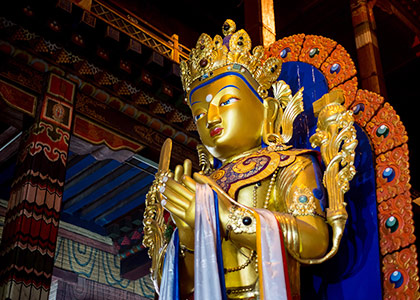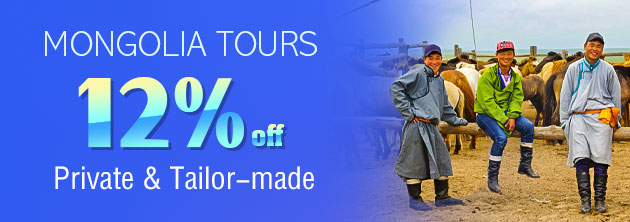Top Things to Do in Mongolia
Top Destination
Ulaanbaatar
Located on the Mongolian Plateau, the city of Ulaanbaatar, originally named Kulun, was built up in 1639. It became the capital city after the Mongolian People's Republic was established in 1924. The word Ulaanbaatar means the city of red heroes. It's now a modern city on prairie with a long and extensive history. In the city, traditional yurts can still be found between the newly constructed skyscrapers.
Top Attractions
1. Ganden Monastery
Ganden Monastery is located in the downtown of Ulaanbaatar and is the largest monastery in the country. Inside the temple the statue of Migjid Janraisig is the most attractive historical relics and also a national treasure. The 28 meters (92 feet) high Buddha is gilded with gold and decorated with jewelry.
|
|
|
2. Gorkhi-Terelj National Park
The Gorkhi-Terelj National Park is about 2 hours drive from Ulaanbaatar. With forests and vast grasslands, it is the place where local people enjoy their holidays. Tourists can experience a horse riding here and have barbecue grilled on stones. Besides,the national park also has vocational villages and yurts for rest, golf course and a breathtaking natural surrounding which offer a perfect place for camping.
3. National Museum of Mongolian History
It is a three-story building which respectively exhibits the ruins of the Stone Age of Mongolia and petroglyph, folk costumes and representative collections showing the nomadic culture such as the armor used in the 12th Century and the letter between Khan and the Pope.
|
|
|
4. Chinggis Square
Chinggis Square is in the city center of Ulaanbaatar. The palace in the north is where the government and parliament are and where the president lives. In front of the gate of the northern palace erects the statue of Chinggis Khaan in a sitting posture. In the center of the Square is the statue of the leader of national independence Sukhbaatar riding a horse.
5. Lake Khövsgöl (Khövsgöl Nuur)
Lake Khövsgöl is well known as the "Blue Pearl of the East" and was designated as one of the four national parks. It lies close to the border of Russia and Mongolia. It is the largest fresh water lake in Mongolia with a coverage of 2,630 square kilometers (1,015 square miles) and depth over 244 meters (800 feet). It is an ecological protection zone since it is home to 68 different species of mammals, 244 kinds of birds and 9 fish.
|
|
|
6. Gobi Desert
Gobi is the largest desert in Asia with exposed bare rocks stretching thousands of miles. It was an important part of Mongol Empire and served as the location of many important cities along the ancient Silk Road. The Gobi Desert is bounded by the Altai Mountains and the steppes to the north, by the Hexi Corridor and Tibetan Plateau to the southwest, and by the North China Plain to the southeast.
Special Activities:

Horse Racing in Naadam Fair
|
 Naadam Fair
Naadam Fair
Naadam means entertainment or games in Mongolian which refers to a grand entertainment activity held in a traditional way. It is an important part of the celebration of the National Day of Mongolia.
As livestock has gained much weight in July, Naadam Fair is held to celebrate a harvest year. It involves horse racing, wrestling, archery, playing chess, dancing and singing. Before the Naadam Fair starts, people of all ages across the country come to the fair to compete or see others competing.
Beside exciting games, Naadam Fair also serves as a platform for trading agricultural and husbandry products such as beef, mutton, cream, cheese, and yogurt.
Food
To fight against coldness due to extreme weather, Mongolian herdsmen eat a lot of high-fat meat and dairy products to keep themselves warm and healthy. Koumiss, grilled meat and roast mutton are their favorite food.
 Khorkhog
Khorkhog
Khorkhog is a well-known Mongolian dish. Stones are first heated by fire. Then they are put into metal cans to cook mutton with water, salt, potatoes and carrots.


